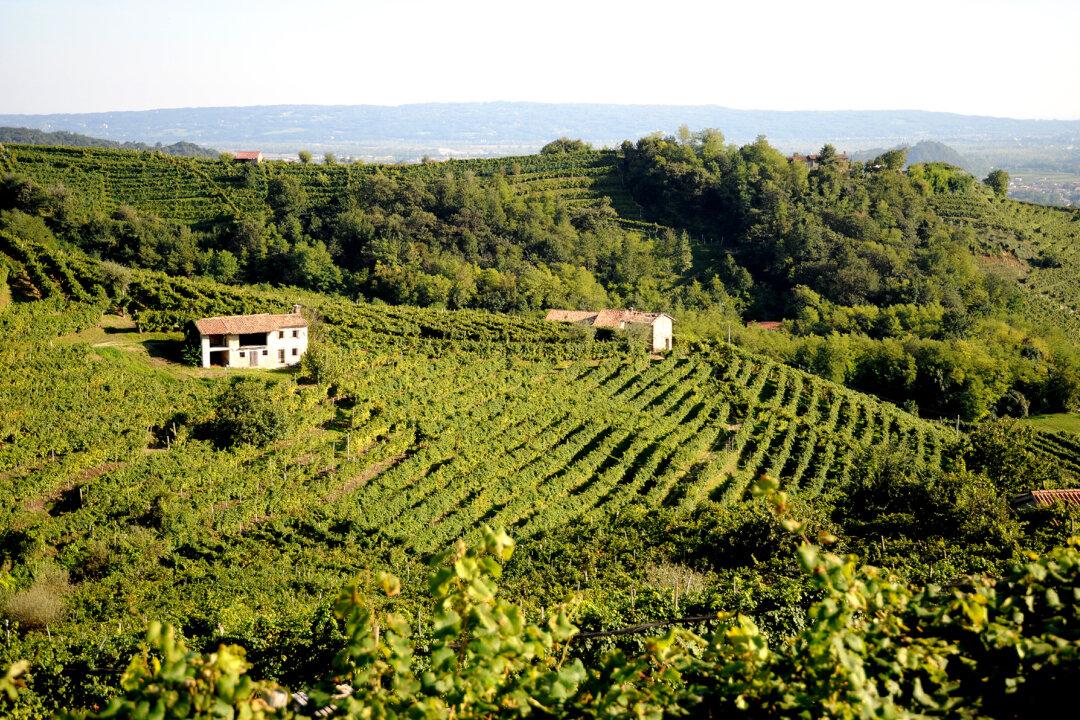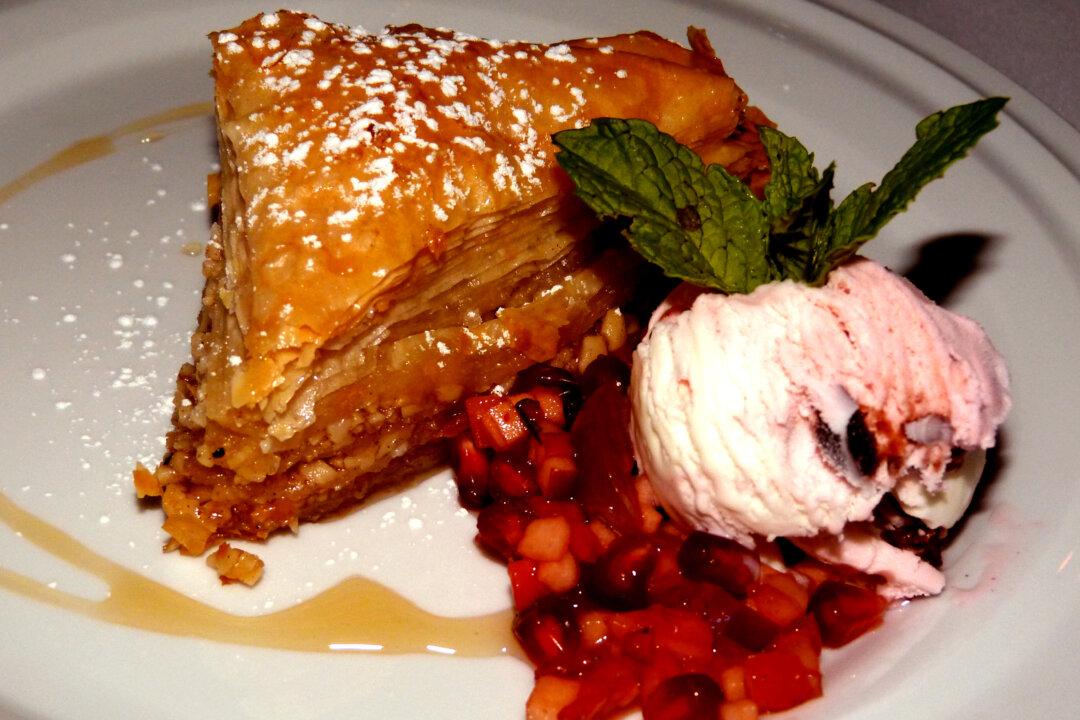Prosecco, evokes an image of Italy’s good life; an image of a food and wine culture that celebrates the bounty of the countryside and the expertise of the winemakers.
About 40 miles from Venice is a hilly terroir that produces one of Italy’s best-known white wines. The wine Prosecco is named after the prosecco grape varietal (nowadays renamed by the Prosecco Consortium as Glera). It is a sparkling wine that comes in many styles—from bone dry to quite sweet—and has either a little carbonation (known as frizzante) or as much carbonation as champagne (known as spumante). The color varies, from almost colorless to light golden yellow.
The official label sweetness designations are:
Brut (less than 15 grams/liter of residual sugar)
Extra Dry (12 to 20 grams/liter of residual sugar)
Dry (17 to 35 grams/liter of residual sugar)
Demi-Sec (33 to 50 grams/liter of residual sugar)
Prosecco is made in the Charmat-Martinotti method: A shorter and less expensive process to making a sparkling wine than méthode champenoise. It replaces the in-bottle secondary fermentation and the lengthy in-bottle cellaring, with a refermentation and short aging phase in a steel-pressurized and refrigerated tank. In 2011, the overall production of Prosecco was about 265 million bottles.
The denizens of La Serenissima, as Venice is still known, drink more Prosecco than any other city in the world. They have it as an aperitivo, they have it as a nightcap, they drink it with meals, and they drink it on every occasion including as a cocktail—the Bellini and the Rossini, Venice’s most famous drinks.
The wine is intensely fruity with white flower and stone fruit aromas and should be drunk young, within a year or two from bottling. This is not a wine to be cellared; normally, its youth is its charm.
Authentic Prosecco has to come from the vineyards of 15 communes between the villages of Conegliano and Valdobbiadene, which is the DOCG production area. DOCG is the acronym for Denominazione di Origine Controllata, or “controlled designation of origin.”
The area lies north of the Piave River, east of the town of Valdobbiadene and west of the village of Farra di Soligo. Stately villas, castles, and medieval hamlets dot the countryside and the vineyards are linked by the Strada del Vino (wine road), which has been a popular tourist itinerary for almost 60 years. The route passes by about 264 acres (107 hectares) of the star-vineyard for Prosecco, Cartizze; a hill covered with vines around the San Pietro di Barbossa parish of Valdobbiadene. Those late-ripening grapes produce the best wines, the very special Superiore di Cartizze, the “grand cru” of the DOCG; wines that can age well for three to four years.
Eleven of the top producers bottle Superiore di Cartizze, and the ones that impressed me most were:
Villa Sandi, a producer in Treviso, has a Cartizze from the single vineyard “Vigna La Rivetta.” A very pale straw, almost colorless sparkler, with an intense, fine and persistent perlage. The palate is fresh, dry, and initially a bit austere but at the same time considerably smooth. Very enjoyable, we had it one evening with Thai food at Taui Jaiya, a Manhattan Thai restaurant. Retails from $38 to $45.
Mionetto also has a nice Spumante Cartizze. It is another light straw colored sparkler that shows stone fruits with a hint of yeast, gentle floral notes (honeysuckle), and some citrus. It is medium bodied with a moderately creamy mousse. On the palate, earthy minerals were upfront followed by honey, apples, and peach. At an average retail price of $35, it is an excellent spumante for the price.
Bisol Desiderio is another Spumante Superiore di Cartizze. Named after the enologist at Bisol—one of the sons in the Bisol family that has been making wines in the Valdobbiadene area since 1542. The wine is very lightly gold-colored, with moderately active perlage, a bit grapy with a hint of citrus. It’s fruity and slightly pungent leading to a short, tart finish. Retail prices vary by area and store, but $25 seems to be the average retail price.
But the star of the DOCG, that is Cartizze, is not the only outstanding Prosecco produced in the Veneto.
Best Winemakers in Prosecco Marketplace
Villa Sandi also creates a Prosecco Superiore Valdobbiadene that is extra dry. It has intensely fruity aromas with hints of chamomile and ripe apples. The palate is fresh with hints of grapefruit, brioche, and gooseberry, very slightly sweet and soft with a fruity but balanced finish.
Nino Franco Spumanti produces Rustico, another brut Prosecco I found very interesting. The color is bright straw; it is very fruity on the nose with apples and faint notes of apricot and citrus. The palate is clean and fresh with light mineral flavors at the finish. Retail price between $12 and $15.
Bellenda, Prosecco Superiore San Fermo, is another brut bottle that is delicate and subtly aromatic. The bottle is vintage dated—my sample was vintage 2012. Brilliant pale, straw yellow, it makes for an excellent aperitif with peach and acacia blossoms on the nose and a crisp and dry finish.
Another nice bottle was from Carpenè Malvolti. This Prosecco has been made by the same family for more than 145 years. It is slightly sweeter than a brut, fruit forward on the nose, a bit grapy, with hints of green apple and pear; it has a moderately creamy mousse, with a fine bead of medium persistence. The medium body is delicate and crisp on the finish. Average price seems to be between $15 and $19.
All the above are some of the close-to-perfect Proseccos available in the US market. They are right for any celebration, seduction, or just sipping.
Manos Angelakis is a well-known wine and food critic based in the New York City area. He has been certified as a Tuscan wine master, by the Tuscan Wine Masters Academy, as well as being an expert on Greek, Chilean, and Brazilian wines. He judges numerous wine competitions each year and is the senior Food & Wine writer for LuxuryWeb Magazine and The Oenophile Blog.




